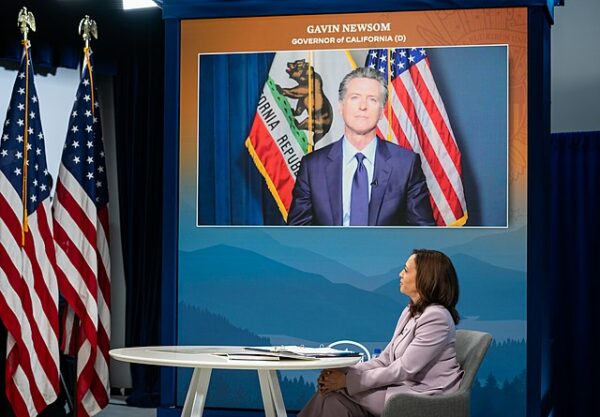
Sometimes you have to ask uncomfortable questions. When looking at what’s been happening in Washington, D.C. over the past decade, one can’t help but wonder: what would our elected officials be doing differently if they were trying to weaken the United States and manage our nation’s decline?
President Biden and the Democrats have spent so much money that the United States of America has seen its credit rating slip.
NPR writes, “Fitch Ratings cut the United States’ credit rating by one notch, from the top-rated AAA to AA+, saying rising deficits and political brinkmanship are imperiling the government’s ability to pay its debts.
The downgrade comes two months after the Biden administration and House Republicans agreed to suspend the government’s debt ceiling in a last minute deal, narrowly avoiding a potentially disastrous federal default.
It marks another rebuke for the U.S., which lost its AAA rating from Standard & Poor’s in 2011 in the midst of another debt ceiling standoff. Today, only one of the three major credit ratings agencies — Moody’s Investors Service — gives the United States a top-notch AAA rating.
But the credit rating agency warned of mounting red ink and an unwillingness in both political parties to grapple with long-term fiscal challenges, while expressing little confidence in the government’s ability to manage the country’s finances.
“In Fitch’s view, there has been a steady deterioration in standards of governance over the last 20 years, including on fiscal and debt matters,” the credit rating agency said in announcing the downgrade. “The repeated debt-limit political standoffs and last-minute resolutions have eroded confidence in fiscal management.”
The White House disagreed with the rating agency that the United States deserved a downgrade, but also, of course, deflected blame and said the real culprits were Republicans.
Press secretary Karine Jean-Pierre released a statement shortly after news broke that Fitch Ratings downgraded the U.S. credit rating, according to The Washington Examiner.
“We strongly disagree with this decision,” Jean-Pierre said. “The ratings model used by Fitch declined under President Trump and then improved under President Biden, and it defies reality to downgrade the United States at a moment when President Biden has delivered the strongest recovery of any major economy in the world.”
Although the Biden administration would like to blame the other guys, this isn’t the first time that the United States has seen its credit ratings slip under a Democratic president.
In 2011, following Pelosi and Obama’s skyrocketing of the national debt, Standard & Poor’s, another credit rating agency, removed the United States government from its list of risk-free borrowers.
Maybe those mean old credit rating agencies just don’t like Democrats?
The New York Times wrote then, “The company, one of three major agencies that offer advice to investors in debt securities, said it was cutting its rating of long-term federal debt to AA+, one notch below the top grade of AAA. It described the decision as a judgment about the nation’s leaders, writing that “the gulf between the political parties” had reduced its confidence in the government’s ability to manage its finances.
“The downgrade reflects our view that the effectiveness, stability, and predictability of American policymaking and political institutions have weakened at a time of ongoing fiscal and economic challenge,” the company said in a statement.
The Obama administration reacted with indignation, noting that the company had made a significant mathematical mistake in a document that it provided to the Treasury Department on Friday afternoon, overstating the federal debt by about $2 trillion.
Standard & Poor’s said the difference could be attributed to a “change in assumptions” in its methodology but that it had “no impact on the rating decision.”
In a release on Friday announcing the downgrade, it warned that the government still needed to make progress in paying its debts to avoid further downgrades.”
Under Biden’s fiscal stewardship, the United States has seen a dramatic rise in inflation, which in turn has put significant pressure on the federal budget by adding to the cost of interest rates the government has to pay for its bloated deficit spending.
CNN reported, “The Treasury Department paid a record $213 billion in interest payments on the national debt in the last quarter of 2022, up $63 billion from the same period a year earlier.
The fourth-quarter tab was also nearly $30 billion more than in the prior quarter, which is the largest quarterly increase on record, said Jerry Dwyer, an economics professor emeritus at Clemson University.
Borrowing costs are expected to become an increasingly heavy burden in coming years. The Congressional Budget Office is set to provide its latest estimate on Wednesday.”
The debt spiral may soon reach crisis proportions. The Peter G. Peterson Foundation figures that “interest payments will run $8.1 trillion over the coming decade. That’s an average of $810 billion a year. By 2032 interest payments will be about $1.2 trillion a year, above expected military outlays. By midcentury, interest costs will be greater than Social Security and Medicare and will account for 40 percent of total revenue.”
For some reason, Fitch did not think adding 80,000 IRS agents to go after waitress tips or spending trillions on “green energy” will fix the problem.
[Read More: Trump Accused Of Scamming Small Donors]











